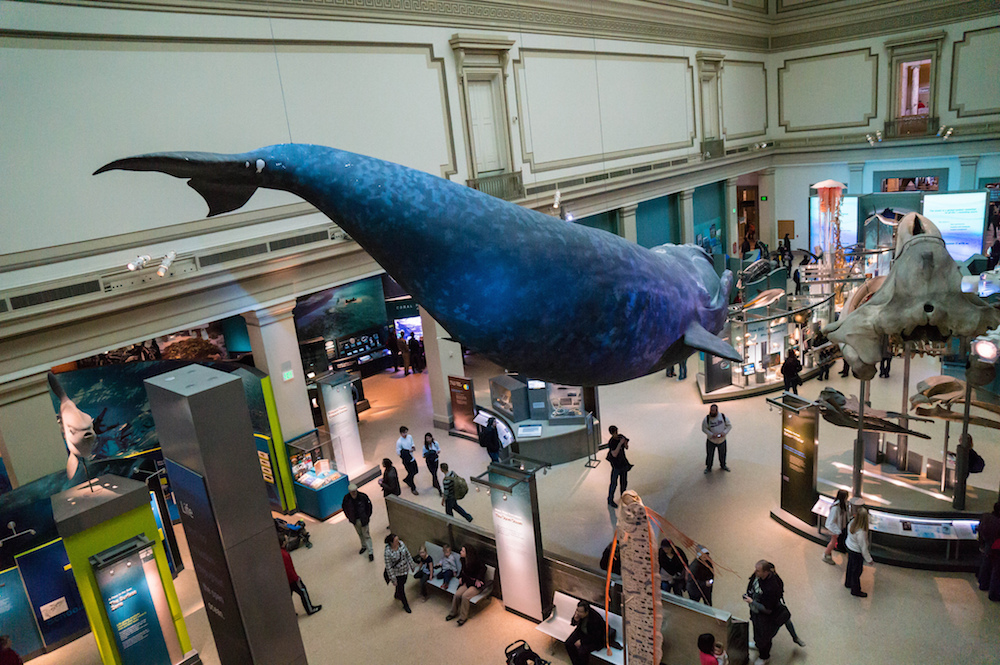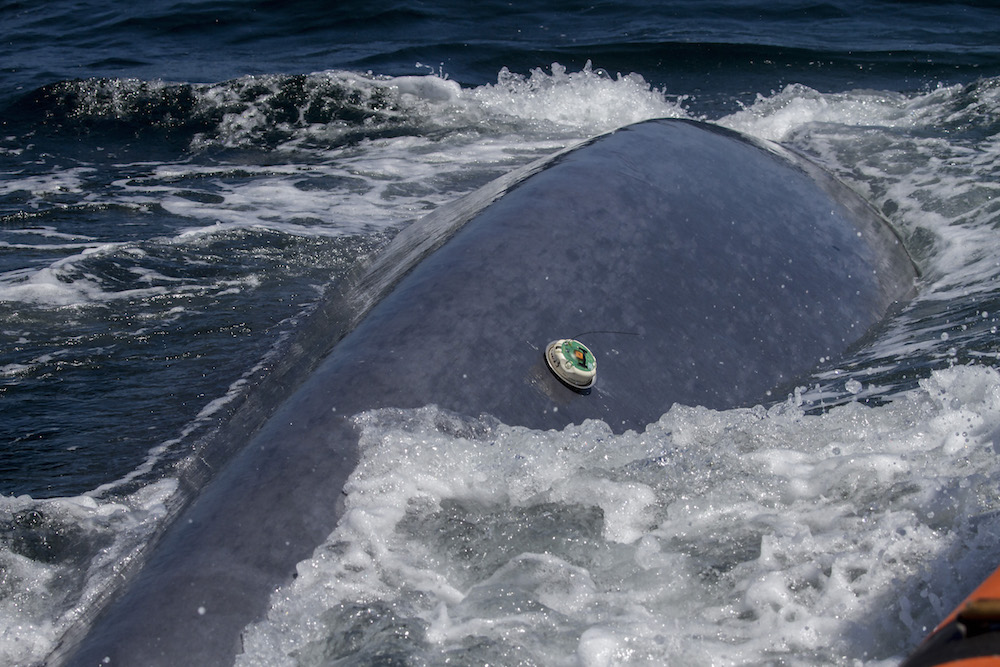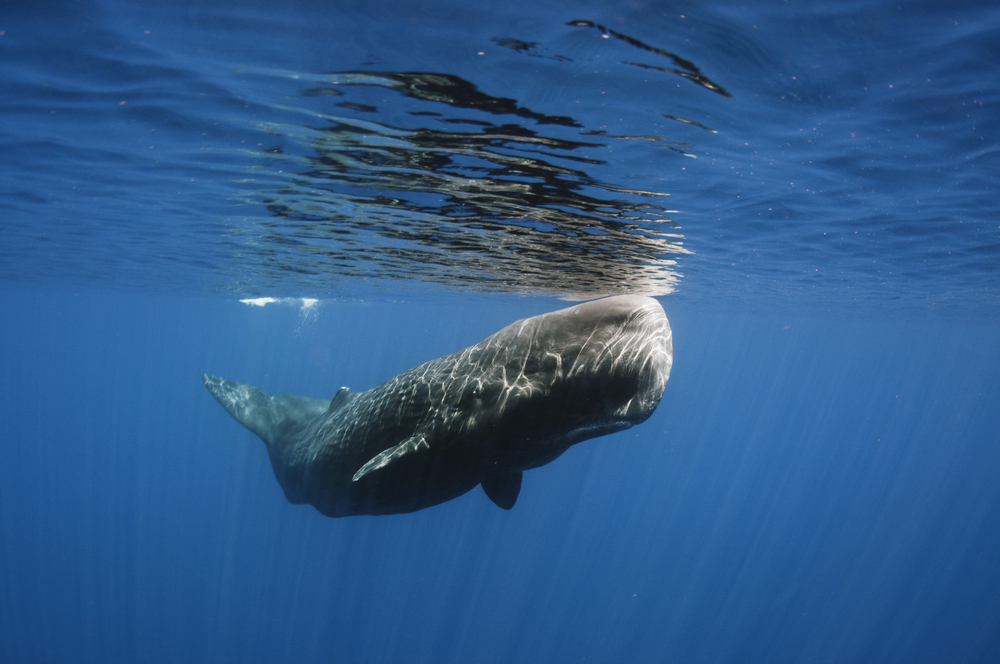
When whales dive beneath the ocean’s surface, what do they do? To answer this question, wildlife researchers need to track these enormous creatures for long periods of time and across great distances. To help with this challenging task, there is a new long-lasting tracking device called the advanced dive behavior (ADB) tag. With this device, researchers can enhance their understanding of whales as well as investigate ocean conditions and the effects of climate change.
The Importance of Tracking Whales
When I think of whales, I picture the giant whale sculpture hanging from the ceiling of the Smithsonian National Museum of Natural History in Washington, D.C. I first saw this whale on a trip to D.C. as a child and it sparked an interest in learning more about these massive creatures. I’m not alone in this regard.

Whale sculpture at the Smithsonian National Museum of Natural History. Image by Powhusku — Own work. Licensed under CC BY-SA 2.0, via Flickr Creative Commons.
Whales have a great impact on marine food chains and are essential to their local ecosystems. As such, researchers look to better understand these animals and protect them from poaching and pollution by tracking their behavior. This requires the use of tracking tags that are able to stay attached to whales for extended periods of time, which is not an easy task due to their active lifestyles.
In response to this need, a research team from Oregon State University investigated the ADB tag, a type of tracking tag that can stay attached to whales for long time periods. We share details about this research in the next section.
ADB Tags Make a Whale of a Difference
When attached to a whale, an ADB tag gathers data ranging from water depth, temperature, and light levels to whale movement and orientation. These tags can also cover wide distances across and beneath the ocean and tell us how whales interact with each other and their prey. In addition to general whale behavior both at the ocean’s surface and well below it, ADB tags can provide data on how whales are affected by passing ships, underwater noises such as sonar, and changes in water temperature.

Tags, like the one pictured above, can help track whales for long periods of time. Image by Oregon State University — Own work. Licensed under CC BY-SA 2.0, via Flickr Creative Commons.
To collect and record whale data, an ADB tag contains control boards that contain a variety of sensors, including light, temperature, and hydrostatic pressure sensors, as well as saltwater conductivity sensors that detect when the tag surfaces. Powered by lithium batteries, the tag also includes three-axis accelerometers and magnetometers for additional data collection. Accelerometers, for instance, can track a whale’s sudden movements and dive behavior. This is all housed in surgical-grade steel and joined with a foam float for use when the tag is released from the whale.
The ADB tag records the data at 1 Hz for the entire time it is deployed, while specific information like GPS locations can be taken at user-specified intervals or times. The ADB tag stores the complete data record on an onboard archive, where it can be accessed by recovering the tag and downloading the records.
The tag remains perpendicular against the whale’s skin to reduce drag until it is released from the body. This can happen when the tag reaches its predetermined release date, is at a low battery capacity, or sheds from the whale prematurely. The tag rises to the ocean’s surface, where it floats until retrieved by researchers. Although finding a small floating device on the ocean may seem near impossible, the tags are equipped with flashing LED lights and can transmit their coordinates.
Implications of Studying Whale Behavior with ADB Tags
By using ADB tags, marine biologists and other researchers can acquire more data on whale behavior — and at a lower cost — than what was previously possible. Earlier technology could only provide tracking data on whale behavior for a little over a day, but with ADB tags, researchers can receive a constant stream of data for up to seven weeks. This provides us with new and exciting possibilities for the level of behavior that we can observe.
The team from Oregon State University tested their tag on three different whale species: sperm whales, fin whales, and blue whales. According to the International Union for the Conservation of Nature (IUCN), sperm whales are vulnerable to extinction, and both fin whales and blue whales are considered endangered species. As such, further information into their lifestyles and migration patterns are important to conserve these whale populations.
By studying a range of whale species, the researchers confirmed that ADB tags can identify varying behaviors. For example, sperm whales are known for being one of the ocean’s deepest-diving animals. As such, data gathered from ADB tags can confirm the depth of their dives. The research team discovered that not only was the tag durable enough to track deep dives, but it successfully indicated that sperm whales can dive over 1000 meters beneath the ocean’s surface.

A sperm whale. Image by Sylke Rohrlach — Own work. Licensed under CC BY 2.0, via Flickr Creative Commons.
Besides investigating whales, ADB tags can be used to collect more information about the ocean as a whole. While the tracked whales travel across miles of open ocean, their tags gather data on various water temperatures. This yields information on global ocean conditions and climate change. As such, ADB tags are seen as a breakthrough technology that can provide a better view of whale behavior and the ocean’s climate.
Read About More Ocean Research
- Get more details on the design and development of the ADB tag:
- B. Mate et al, “The development of an intermediate-duration tag to characterize the diving behavior of large whales“, Ecology and Evolution, vol. 6, issue 24, (2016).
- From ScienceDaily: “New tag revolutionizes whale research, and makes them partners in science“
- See how one team studied the impact of offshore wind farms on marine life in Seas of Change for Wind Turbines
- Check out these blog posts on marine applications of science and technology:



Comments (0)